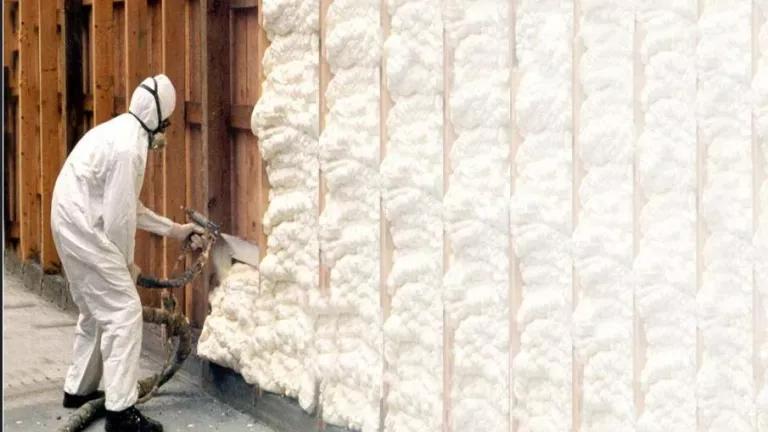Cheaper Insulation: Is it Worth it?

The Truth behind Spray Polyurethane Foam
Guest blog by Dr. Shuchi Agarwal, MD, MPH; University of California, San Francisco Occupational and Environmental Medicine Program
The California Department of Toxic Substances Control (DTSC) Safer Consumer Products Program identifies methylene diphenyl diisocyanates (MDI) in spray polyurethane foam (spray foam) as a chemical of concern for its priority product profile. Never heard of diisocyanates? You are not alone. Diisocyanates are toxic chemicals widely used in many building materials, thus it’s important to understand why DTSC did this and the associated health risks.
What is spray foam and what is it used for?
Spray foam is a popular residential and office building insulation material. It’s made from two liquid components: Part A and Part B. Part A contains diisocyanates, which are highly active molecular compounds and Part B contains a variety of other chemicals such as polyols, flame retardants and amines. In order to produce spray foam, Parts A and B are mixed together and undergo a “curing” process in which a chemical reaction occurs that creates a harder material-- the foam.
Spray foam has been marketed as a “green solution” due to its insulation efficiency and low cost. But unfortunately, significant data demonstrate that isocyanates are associated with detrimental health effects.
Exposure and Health Effects
The first reported hazards associated with isocyanate exposure go back to the 1950s. Today isocyanates are one of the most common causes of work-related asthma. “Work-related asthma” includes two groups of individuals:
- Individuals with newly diagnosed asthma caused by exposures at work
- Individuals with asthma whose symptoms are aggravated at work
Isocyanates can enter people’s bodies while they are applying or near the application of isocyanate containing products like spray foam. Most often people can breathe in isocyanates or absorb them through their skin, and contact with isocyanates primarily affects the lungs and skin. Isocyanates can irritate the inner lining of the nose and lungs causing inflammation and difficulty breathing (Baur 1995; Engfeldt 2013; Goossens 2003). Similarly, skin contact can result in irritation, swelling, rashes, or blistering. The population at greatest risk is workers who manufacture and/or apply spray foam. While workers are at increased risk of harm, consumers exposed to spray foam can be affected too.
One study reported that after having isocyanate containing spray foam insulation installed in their attic, two people were diagnosed with asthma and/or reactive airway disease. Ultimately, due to their symptoms they were forced to move out of their home. In another study, 13 individuals from 10 households developed symptoms of watery eyes, sinus congestion, throat irritation, and/or headaches after having their homes retrofitted with spray foam. Unfortunately, many of them continued to experience symptoms even after the spray foam application finished.
What can we do to protect ourselves?
Preventing exposure to isocyanates is extremely important in order to avoid negative health impacts. Complete elimination of these chemicals from spray foam would be best. In fact just last year the Presidential Green Chemistry Challenge was awarded to a company that designed polyurethane foam without isocyanates. While this is a step in the right direction, it may still take several years of R&D and green chemistry work before the industry completely removes isocyanates and only uses safer alternatives. In the meantime, consumers should consider other kinds of insulation materials such as cellulose, natural fibers, and mineral wool that are safer for our health.
If you do have spray foam insulation applied at home, it is critical to leave during the application process and not return until instructed to. The curing process can range anywhere from 7 to 72 hours, thus it is best to follow the manufacturer’s guidance as to the best time to reenter the home. Additionally, consumers should ensure proper ventilation in their homes by opening windows and doors to reduce any exposure from off gassing materials.
Ventilation is also crucial for workers to minimize isocyanate exposure during spray foam application. Additionally, workers need training and personal protective equipment such as face shields, goggles, respirators and protective clothing while working with spray foam, as shown in the picture. Employers and workers should also learn to recognize signs and symptoms such as cough, wheezing, headache, and watery eyes, which may indicate isocyanate exposure and necessitate immediate removal from the worksite and medical consultation.
Currently, there are five states, one being California, that track cases of work-related asthma. The goal of the collaboration between the California Department of Public Health and healthcare providers is to collect cases of work-related asthma, report them to the public health department and work on prevention efforts.
Ultimately, it is going to take a joint effort between the manufacturers, workers, consumers, scientists, physicians, and policy makers to help remove these harmful chemicals from our environment. As DTSC moves forward it will be interesting to see what they will decide; perhaps a way to substitute isocyanates or at least a safer alternative.



